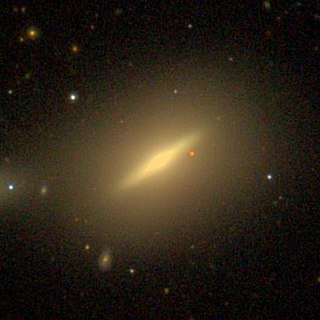Related Research Articles

Sphingolipids are a class of lipids containing a backbone of sphingoid bases, which are a set of aliphatic amino alcohols that includes sphingosine. They were discovered in brain extracts in the 1870s and were named after the mythological sphinx because of their enigmatic nature. These compounds play important roles in signal transduction and cell recognition. Sphingolipidoses, or disorders of sphingolipid metabolism, have particular impact on neural tissue. A sphingolipid with a terminal hydroxyl group is a ceramide. Other common groups bonded to the terminal oxygen atom include phosphocholine, yielding a sphingomyelin, and various sugar monomers or dimers, yielding cerebrosides and globosides, respectively. Cerebrosides and globosides are collectively known as glycosphingolipids.

Sphingomyelin is a type of sphingolipid found in animal cell membranes, especially in the membranous myelin sheath that surrounds some nerve cell axons. It usually consists of phosphocholine and ceramide, or a phosphoethanolamine head group; therefore, sphingomyelins can also be classified as sphingophospholipids. In humans, SPH represents ~85% of all sphingolipids, and typically make up 10–20 mol % of plasma membrane lipids.
Sphingosine (2-amino-4-trans-octadecene-1,3-diol) is an 18-carbon amino alcohol with an unsaturated hydrocarbon chain, which forms a primary part of sphingolipids, a class of cell membrane lipids that include sphingomyelin, an important phospholipid.

Ceramides are a family of waxy lipid molecules. A ceramide is composed of sphingosine and a fatty acid joined by an amide bond. Ceramides are found in high concentrations within the cell membrane of eukaryotic cells, since they are component lipids that make up sphingomyelin, one of the major lipids in the lipid bilayer. Contrary to previous assumptions that ceramides and other sphingolipids found in cell membrane were purely supporting structural elements, ceramide can participate in a variety of cellular signaling: examples include regulating differentiation, proliferation, and programmed cell death (PCD) of cells.

Cerebrosides (monoglycosylceramides) are a group of glycosphingolipids which are important components of animal muscle and nerve cell membranes.

Glucocerebroside is any of the cerebrosides in which the monosaccharide head group is glucose.

Sphingolipidoses are a class of lipid storage disorders or degenerative storage disorders caused by deficiency of an enzyme that is required for the catabolism of lipids that contain ceramide, also relating to sphingolipid metabolism. The main members of this group are Niemann–Pick disease, Fabry disease, Krabbe disease, Gaucher disease, Tay–Sachs disease and metachromatic leukodystrophy. They are generally inherited in an autosomal recessive fashion, but notably Fabry disease is X-linked recessive. Taken together, sphingolipidoses have an incidence of approximately 1 in 10,000, but substantially more in certain populations such as Ashkenazi Jews. Enzyme replacement therapy is available to treat mainly Fabry disease and Gaucher disease, and people with these types of sphingolipidoses may live well into adulthood. The other types are generally fatal by age 1 to 5 years for infantile forms, but progression may be mild for juvenile- or adult-onset forms.

Lipid signaling, broadly defined, refers to any biological cell signaling event involving a lipid messenger that binds a protein target, such as a receptor, kinase or phosphatase, which in turn mediate the effects of these lipids on specific cellular responses. Lipid signaling is thought to be qualitatively different from other classical signaling paradigms because lipids can freely diffuse through membranes. One consequence of this is that lipid messengers cannot be stored in vesicles prior to release and so are often biosynthesized "on demand" at their intended site of action. As such, many lipid signaling molecules cannot circulate freely in solution but, rather, exist bound to special carrier proteins in serum.

Globosides are a sub-class of the lipid class glycosphingolipid with three to nine sugar molecules as the side chain of ceramide. The sugars are usually a combination of N-acetylgalactosamine, D-glucose or D-galactose. One characteristic of globosides is that the "core" sugars consists of Glucose-Galactose-Galactose (Ceramide-βGlc4-1βGal4-1αGal), like in the case of the most basic globoside, globotriaosylceramide (Gb3), also known as pk-antigen. Another important characteristic of globosides is that they are neutral at pH 7, because they usually do not contain neuraminic acid, a sugar with an acidic carboxy-group. However, some globosides with the core structure Cer-Glc-Gal-Gal do contain neuraminic acid, e.g. the globo-series glycosphingolipid "SSEA-4-antigen".
Ceramidase is an enzyme which cleaves fatty acids from ceramide, producing sphingosine (SPH) which in turn is phosphorylated by a sphingosine kinase to form sphingosine-1-phosphate (S1P).
In enzymology, a lactosylceramide alpha-2,3-sialyltransferase is an enzyme that catalyzes the chemical reaction
In enzymology, a sphingomyelin synthase is an enzyme that catalyzes the chemical reaction

Collagen type IV alpha-3-binding protein, also known as ceramide transfer protein (CERT) or StAR-related lipid transfer protein 11 (STARD11) is a protein that in humans is encoded by the COL4A3BP gene. The protein contains a pleckstrin homology domain at its amino terminus and a START domain towards the end of the molecule. It is a member of the StarD2 subfamily of START domain proteins.

Ceramide glucosyltransferase is an enzyme that in humans is encoded by the UGCG gene.

Probable dolichyl pyrophosphate Glc1Man9GlcNAc2 alpha-1,3-glucosyltransferase is an enzyme that in humans is encoded by the ALG8 gene.

2-hydroxyacylsphingosine 1-beta-galactosyltransferase is an enzyme that in humans is encoded by the UGT8 gene.
O-linked glycosylation is the attachment of a sugar molecule to the oxygen atom of serine (Ser) or threonine (Thr) residues in a protein. O-glycosylation is a post-translational modification that occurs after the protein has been synthesised. In eukaryotes, it occurs in the endoplasmic reticulum, Golgi apparatus and occasionally in the cytoplasm; in prokaryotes, it occurs in the cytoplasm. Several different sugars can be added to the serine or threonine, and they affect the protein in different ways by changing protein stability and regulating protein activity. O-glycans, which are the sugars added to the serine or threonine, have numerous functions throughout the body, including trafficking of cells in the immune system, allowing recognition of foreign material, controlling cell metabolism and providing cartilage and tendon flexibility. Because of the many functions they have, changes in O-glycosylation are important in many diseases including cancer, diabetes and Alzheimer's. O-glycosylation occurs in all domains of life, including eukaryotes, archaea and a number of pathogenic bacteria including Burkholderia cenocepacia, Neisseria gonorrhoeae and Acinetobacter baumannii.
(N-acetylneuraminyl)-galactosylglucosylceramide N-acetylgalactosaminyltransferase is an enzyme with systematic name UDP-N-acetyl-D-galactosamine:1-O-(O- - -O-beta-D-galactopyranosyl- -beta-D-glucopyranosyl)-ceramide 4-beta-N-acetyl-D-galactosaminyltransferase. This enzyme catalyses the following chemical reaction:

NGC 4638 is an edge-on lenticular galaxy located about 50 million light-years away in the constellation Virgo. NGC 4638 was discovered by astronomer William Herschel on March 15, 1784. The galaxy is a member of the Virgo Cluster.
References
- ↑ Ichikawa S, Sakiyama H, Suzuki G, Hidari KI, Hirabayashi Y (May 1996). "Expression cloning of a cDNA for human ceramide glucosyltransferase that catalyzes the first glycosylation step of glycosphingolipid synthesis". Proceedings of the National Academy of Sciences of the United States of America. 93 (10): 4638–43. doi: 10.1073/pnas.93.10.4638 . PMC 39331 . PMID 8643456.